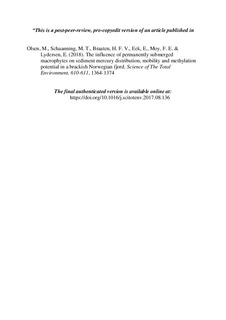| dc.contributor.author | Olsen, Marianne | |
| dc.contributor.author | Schaanning, Morten | |
| dc.contributor.author | Braaten, Hans Fredrik Veiteberg | |
| dc.contributor.author | Eek, Espen | |
| dc.contributor.author | Moy, Frithjof Emil | |
| dc.contributor.author | Lydersen, Espen | |
| dc.date.accessioned | 2019-03-05T11:53:39Z | |
| dc.date.available | 2019-03-05T11:53:39Z | |
| dc.date.created | 2017-08-30T08:37:23Z | |
| dc.date.issued | 2018 | |
| dc.identifier.citation | Science of the Total Environment. 2018, 610-611, 1364-1374. | nb_NO |
| dc.identifier.issn | 0048-9697 | |
| dc.identifier.uri | http://hdl.handle.net/11250/2588738 | |
| dc.description.abstract | Macrophytes are shown to affect the microbial activity in different aqueous environments, with an altering of the sediment cycling of mercury (Hg) as a potential effect. Here, we investigated how a meadow with permanently submerged macrophytes in a contaminated brackish fjord in southern Norway influenced the conditions for sulfate reducing microbial activity, the methyl-Hg (MeHg) production and the availability of MeHg. Historically discharged Hg from a chlor-alkali plant (60–80 tons, 1947–1987) was evident through high Hg concentrations (491 mg Tot-Hg kg− 1, 268 μg MeHg kg− 1) in intermediate sediment depths (10–20 cm) outside of the meadow, with reduced concentrations within the meadow. Natural recovery of the fjord was revealed by lower sediment surface concentrations (1.9–15.5 mg Tot-Hg kg− 1, 1.3–3.2 μg MeHg kg− 1). Within the meadow, vertical gradients of sediment hydrogen sulfide (H2S) Eh and pH suggested microbial sulfate reduction in 2–5 cm depths, coinciding with peak values of relative MeHg levels (0.5% MeHg). We assume that MeHg production rates was stimulated by the supply and availability of organic carbon, microbial activity and a sulfide oxidizing agent (e.g. O2) within the rhizosphere. Following this, % MeHg in sediment (0–5 cm) within the meadow was approximately 10 × higher compared to outside the meadow. Further, enhanced availability of MeHg within the meadow was demonstrated by significantly higher fluxes (p < 0.01) from sediment to overlying water (0.1–0.6 ng m− 2 d− 1) compared to sediment without macrophytes (0.02–0.2 ng m− 2 d− 1). Considering the productivity and species richness typical for such habitats, submerged macrophyte meadows located within legacy Hg contaminated sediment sites may constitute important entry points for MeHg into food webs. | nb_NO |
| dc.description.abstract | The influence of permanently submerged macrophytes on sediment mercury distribution, mobility and methylation potential in a brackish Norwegian fjord | nb_NO |
| dc.language.iso | eng | nb_NO |
| dc.title | The influence of permanently submerged macrophytes on sediment mercury distribution, mobility and methylation potential in a brackish Norwegian fjord | nb_NO |
| dc.title.alternative | The influence of permanently submerged macrophytes on sediment mercury distribution, mobility and methylation potential in a brackish Norwegian fjord | nb_NO |
| dc.type | Journal article | nb_NO |
| dc.type | Peer reviewed | nb_NO |
| dc.description.version | acceptedVersion | nb_NO |
| dc.source.pagenumber | 1364-1374 | nb_NO |
| dc.source.volume | 610-611 | nb_NO |
| dc.source.journal | Science of the Total Environment | nb_NO |
| dc.identifier.doi | 10.1016/j.scitotenv.2017.08.136 | |
| dc.identifier.cristin | 1489711 | |
| cristin.unitcode | 222,58,1,0 | |
| cristin.unitname | Institutt for natur, helse og miljø | |
| cristin.ispublished | true | |
| cristin.fulltext | postprint | |
| cristin.qualitycode | 2 | |
